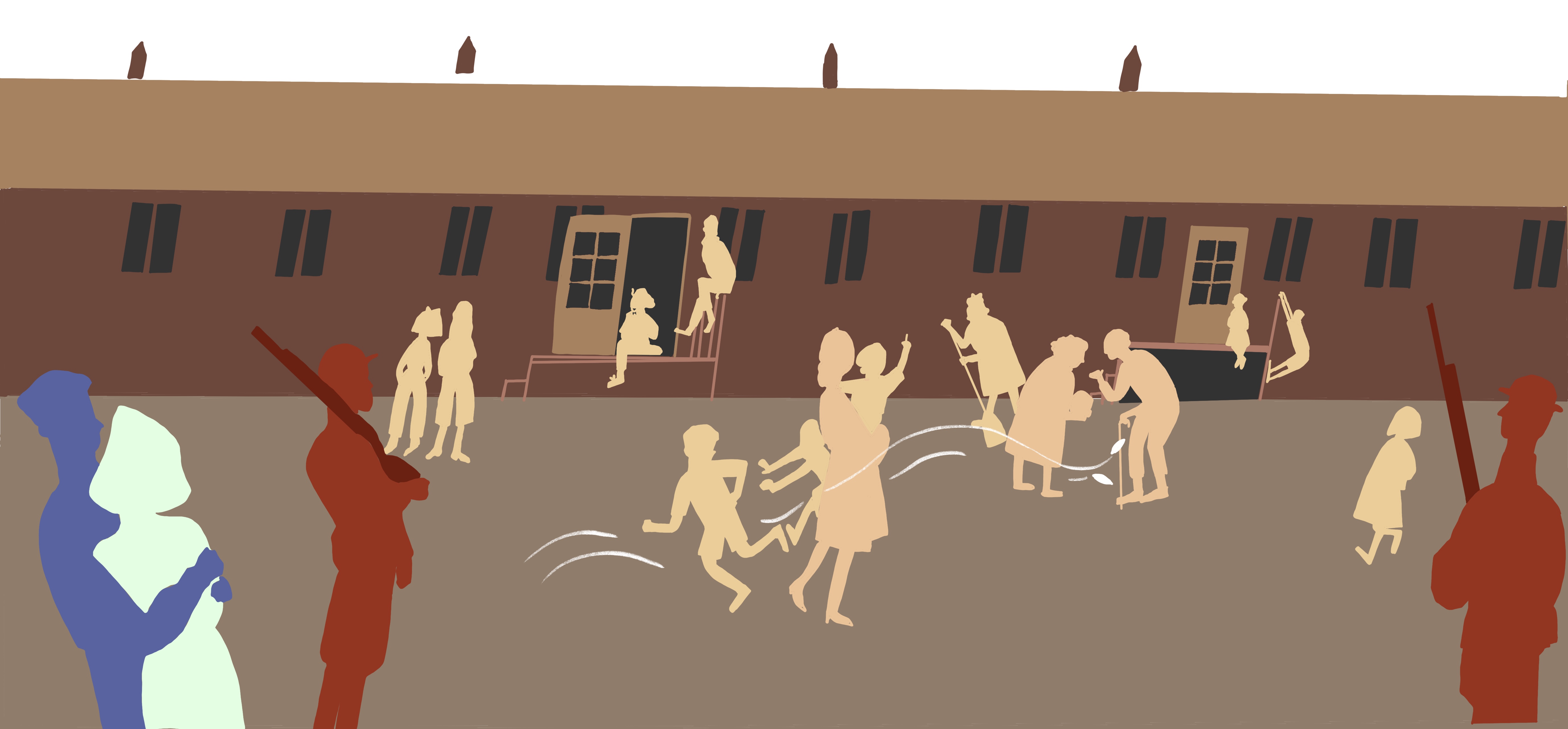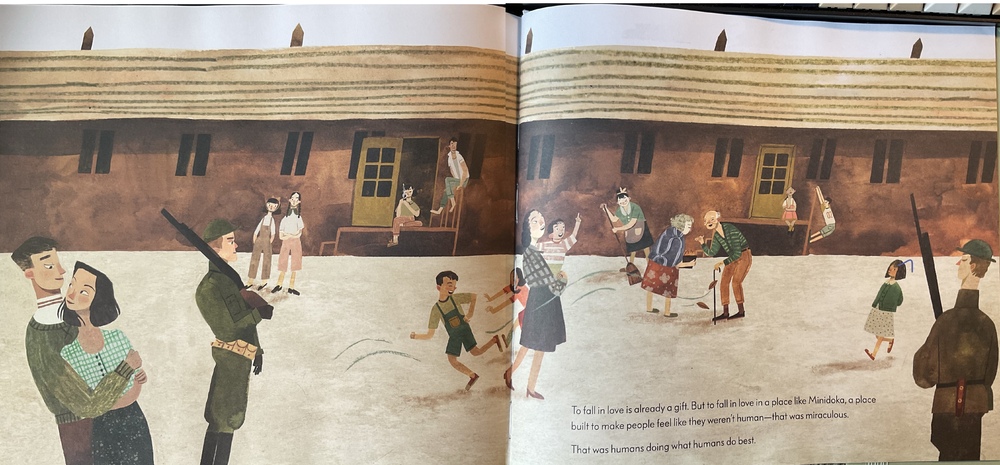How the book works and why the book matters
Love in the Library, written by Maggie Tokuda-Hall and illustrated by Yas Imamura, is a retelling of how Tokuda-Hall’s own grandparents met in the Minidoka Japanese internment camp in Idaho, during World War II. It is a sweet, quiet story of resistance in the most human of ways—falling in love.
It is an attractive book. Imamura’s art is warm and welcoming, contrasting the conditions faced by the prisoners of Minidoka, and Tokuda-Hall’s words are gentle, generous, and deeply empathetic to the plight of the prisoners. Love in the Library slides into the category of historical picturebooks, or more specifically, picturebooks about history. Unlike most picturebooks in that genre which teaches children about an important event in history, Love in the Library is, instead, a story that takes place during an event in American history, one that is often overlooked due to its dark nature.
After the 1941 attack on Pearl Harbor, President Franklin D. Roosevelt signed an executive order that would see over 100,000 Japanese-Americans incarcerated for the mere crime of sharing an ethnicity with a hostile country. They lost their jobs and their homes and were forcibly relocated to camps located far away from the coast—a move that contributed to the dehumanization of a people that made a large part of their living from the fishing industry.
Love in the Library celebrates the persistence and optimism of the incarcerated Japanese-Americans by highlighting an everyday method of resistance: refusing to be dehumanized by falling in love and having a family. It has been described as “empowering” and “important” in its portrayal of an unjust period of American history, and Tokuda-Hall herself leans into its message in her author’s note:
“Though it is always easier to destroy than it is to build, reminding myself of stories like Tama and George’s reminds me to hope. To let my heart seek out the beauty and the peace the marginalized miraculously create for themselves. To let myself imagine a future where that love is not improbable, but easy. To force myself to fight for that future. […] Because if we can fall in love, if we can find our joy, if we can find that miracle despite all of these truths—What else can we do?”
Contradictorily praised for its portrayal of a racially unjust time and challenged for Tokuda-Hall’s explicit naming of racism as a root of American society, Love in the Library is a fantastic example of the power of teaching history through stories and how fraught the conversation continues to be. When Scholastic chose to acquire Love in the Library for its AANHPI collection on the condition of removing Tokuda-Hall’s references to racism, they acknowledged that these stories are crucial to the early learner pedagogy but still bowed to the pressures of social conservatives. It seemed that Love in the Library was educational enough about a period of racial injustice that they wanted to license it, but it had gone too far in explicitly pointing out that the racism that created the camps still exists today. Education, therefore, was not truly their goal.
In his paper “Using Multicultural Picture Books to Promote Racial Justice in Urban Early Childhood Literacy Classrooms,” Terry Husband describes the importance of teaching children about racial justice, especially at the age where picturebooks are their primary form of literature. He advocates against colourblind methods of teaching—that is, an approach that “[focuses] more on commonalities that exist in and across various student populations”—as a colourblind approach underestimates children’s capability to empathize with others and to understand racial injustices.
Teaching children about injustices isn’t just about instilling optimism and resistance in young people. It is also important to help sensitize children to racial injustices they might encounter in their day-to-day lives. A 2009 study showed that racialized children are well aware of the negative stereotypes that affect them and are more likely to “behave in a manner that is consistent with a particular negative stereotype when they are in social contexts where the negative stereotype is accepted by the majority of other social groups.” In other words, racialized children might not see a point in combating negative stereotypes if the other children around them expect them to act that way.
A 2019 study showed that children develop implicit racial biases quite early—and this is the result of their parents’ racial attitudes rubbing off on their children. Therefore, it becomes crucial that children are taught to recognize and refute these biases before they become solidified in their thought processes. This is why it is important for early childhood teachers to include works about racial injustice in their teaching materials.
Further, a 2010 study by Apfelbaum et al. found that students who were taught lessons where racial diversity was minimized or ignored were less likely to recognize such injustices. It is the children who participated in lessons that emphasized racial diversity who were more sensitive to occurrences. Books that actively incorporate lessons of racial diversity are thus important in teaching children to see their world more true to the injustices that lie therein
In early childhood education, this can be done through the use of multicultural picturebooks. According to Husband, multicultural picturebooks are an “important tool in this process of stereotype reduction, as they provide children with opportunities to see and learn about various racial groups in the world in non-stereotypical ways.”
When we consider that children’s literature are some of the most targeted books by right-wing, Christian nationalists, it is unsurprising that large numbers of books discussing race and diversity are challenged by these groups. Based on a 2020 survey by the American Library Association of the top 10 most challenged books, six out of the ten touched on topics of race and racial injustice. In 2023, the list has shifted toward LGBTQ content.
For the more information on book challenges, click on the links below:
- Books that touched on race were among the most challenged as inappropriate for libraries in 2020 — CNN
- Top 10 Most Challenged Books and Frequently Challenged Books Archive — ALA
What the controversy surrounding Love in the Library tells us is that people are willing to teach children about historical wrongdoings so long as we keep them in the past. Don’t connect these injustices to the current-day lives of Americans, don’t act like people are still upset. It happened so long ago! Nobody would dare be so racist now.
But Tokuda-Hall’s intent was to instil hope into young children of colour. By showing them that love can happen—miraculously—in such a terrible place, we can imagine a future where love can be formed more openly and easily.
Tokuda-Hall’s Love in the Library provides an excellent opportunity to discuss wrongdoings both past and present. As a historical book based on real people, it presents educators with a springboard to jump into discussions of systemic racism and how that affects people to this day. After all, it wasn’t until over 40 years later that the United States government delivered an apology to Japanese-Americans, addressing their unjust treatment.
Husband notes that the studies done on early childhood education and racial biases suggest that “avoiding discussions of race and racism in the classroom can actually make children desensitized to issues of racial injustice in society.” By presenting the story of her grandparents’ relationship and marriage, Tokuda-Hall creates a story that weaves the injustice that her grandparents faced while humanizing the prisoners of the Minidoka incarceration camp. She makes it clear that the circumstances that her grandparents faced—and by extension, the other prisoners as well—were “uncomfortable and unjust.”
Yas Imamura injects the story with a crucial visual aspect that manages to both emphasize the desolate nature of the camp and its surroundings and also the intimate, almost cozy aspect of the day-to-day life within Minidoka. She drapes the prisoners in warm, colourful hues and gives their living spaces small, personal touches of filigree details, tiny illustrations, and photographs. The background is barren in contrast, with dull brown hues that are accented by the imperfect nature of her chosen mediums of watercolour and gouache
Love in the Library embodies a “safe” way to teach children about racial injustice, tolerable to right-wing conservatives. But it also allows teachers to delve into the historical context and on-going plight of the racialized and othered in North America. While conservatives might be willing to teach this book to children if they frame the injustices portrayed as being solely in the past, Tokuda-Hall’s author’s note is sure to explicitly mention similar injustices that were widely discussed around the time that the book was published: Muslim bans and police brutality. For teachers and parents willing to educate their children on racial biases, Love in the Library provides a window to learn about systemic racism as the forced relocation and incarceration of Japanese-Americans can lead to a discussion of the treatment of minorities during war-time and how some things have gotten better and how others have not. Ultimately, Love in the Library is a sweet, hopeful story that teaches children how to find the best in the worst of places.
Sources
Ali, Shirin. “Books that touched on race were among the most challenged as inappropriate for libraries in 2020.” CNN, 11 Apr 2021, https://www.cnn.com/2021/04/11/us/challenges-to-books-about-racism-trnd/index.html. Accessed 17 Jul 2024.
Husband, Terry. “Using Multicultural Picture Books to Promote Racial Justice in Urban Early Childhood Literacy Classrooms.” Urban Education, vol. 54, no. 8, 2019, pp. 1058-1084.
Tokuda-Hall, Maggie. “Scholastic, and a Faustian Bargain.” Pretty OK Maggie, https://www.prettyokmaggie.com/blog/2023/4/11/scholastic-and-a-faustian-bargain. Accessed 15 Jul 2024.
”Top 10 Most Challenged Books of 2023.” American Library Association, https://www.ala.org/bbooks/frequentlychallengedbooks/top10. Accessed 30 Jul 2024.
Ujifusa, Andrew. "Sure, We Teach History. But Do We Know Why It's Important?" Education Week, vol. 39, no. 17, 2020, p. 4.
LOVE IN THE LIBRARY
Text copyright © 2021 by Maggie Tokuda-Hall. Illustrations copyright © 2021 by Yas Imamura. Reproduced by permission of the publisher, Candlewick Press, Somerville, MA.


